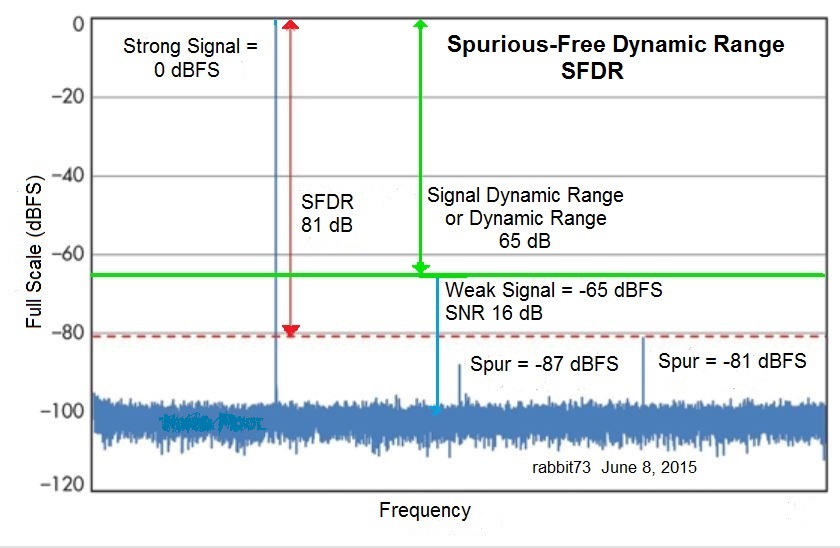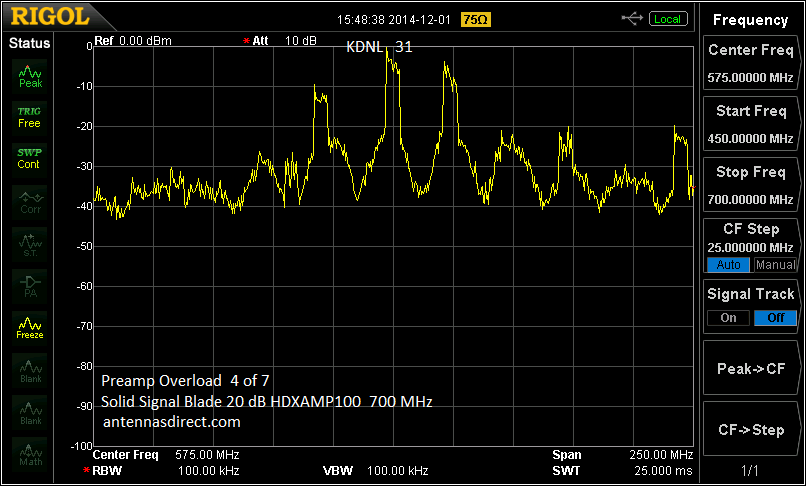Quote:
|
Yes, anything you have to offer for my education and learning is an absolute asset. For me and everyone.
|
OK, now the short course:
THREE TYPES OF OVERLOAD
There are three types of preamp or tuner overload, in order of increasing signal strength:
1. The strong signals almost cause enough intermodulation distortion (IMD) to interfere with the reception of weak desired signals, but the spurious signals are at or below the noise floor of the weak signals. This is the point that holl_ands uses in his preamp charts to obtain max SFDR (Spurious Free Dynamic Range). No damage will happen.
As the strongest signals continue to increase in strength, more of the weaker signals are damaged until you reach:
2. The strong signals cause overload to the preamp or tuner that makes it impossible to receive any signals. No damage will happen. The strongest signals are still there, but they can't be decoded because the IMD products have damaged them so that they contain more errors (high BER....bit error ratio/rate) than can be corrected by the FEC (forward error correction).
3. The signals are so strong that the input transistor is toast. You are not likely to encounter OTA signals that strong, unless you live next door to a high power transmitter and you have your high gain antenna aimed at the transmitter's antenna.
As a general rule, tuners can tolerate stronger signals than preamps before overload. The difference in strength is approx. equal to the preamp gain.
Forum member holl_ands has made a preamp chart that shows the maximum input signal for preamps. Many of the preamps are no longer available, but it gives you the general idea.
http://imageevent.com/holl_ands/file...=0&w=1&s=0&z=4
Intermodulation Distortion
The IMD creates new spurious signals within the preamp (or tuner) itself that can interfere with the reception of your weakest desired signals if the spurious signals are stronger than the noise floor of the weakest desired signals. The spurious signals are caused by the interaction between two or more of your strongest signals.
IMD is not the only distortion that can be created within the preamp; you can also have distortion caused by signals so strong that the top of the strong signals are clipped, which causes compression of the signals. This can be seen if you increase the input to the preamp by, for example, 10 dB and the output increases by less than 10 dB.
Spurious Free Dynamic Range
The Spurious Free Dynamic Range needed is the difference in strength between your strongest signal and your weakest desired signal, plus 16 dB for the SNR of the weakest signal, using the dBm Pwr scale on your tvfool report. This difference is expressed in terms of dB, not dBm, because the original units are the same. The difference between the strongest signal and the weakest signal is the Signal Dynamic Range/Dynamic Range, which is 16 db less than the SFDR, because it doesn't include the SNR of the weakest signal.

Another way to think of SFDR is from the top of the strongest signal down to the bottom (noise floor) of the weakest desired signal. The top of the spurious signals must be at or below the noise floor of the weak signals if they are not to cause interference. The Signal Dynamic Range is from the top of the strongest signal down to the top of the weakest desired signal.
You can also use the NM scale for your calculations, but I prefer to use the Pwr scale because most tuners drop out around -85 dBm.
ADTech did some interesting tests with a spectrum analyzer that show how weak signals are damaged when a preamp is overloaded by strong signals:
Just the antenna, no preamp:

This is what the same signals look like when the preamp is moderately overloaded. Notice that the weakest signals are damaged first. The noise floor rises from the spurious signals created by the IMD. This reduces the SNR of the weak signals to less than the required 15 dB minimum:

This is what the same signals look like with a badly overloaded preamp:

This is what the same signals look like with a high quality preamp that isn't easily overloaded:
